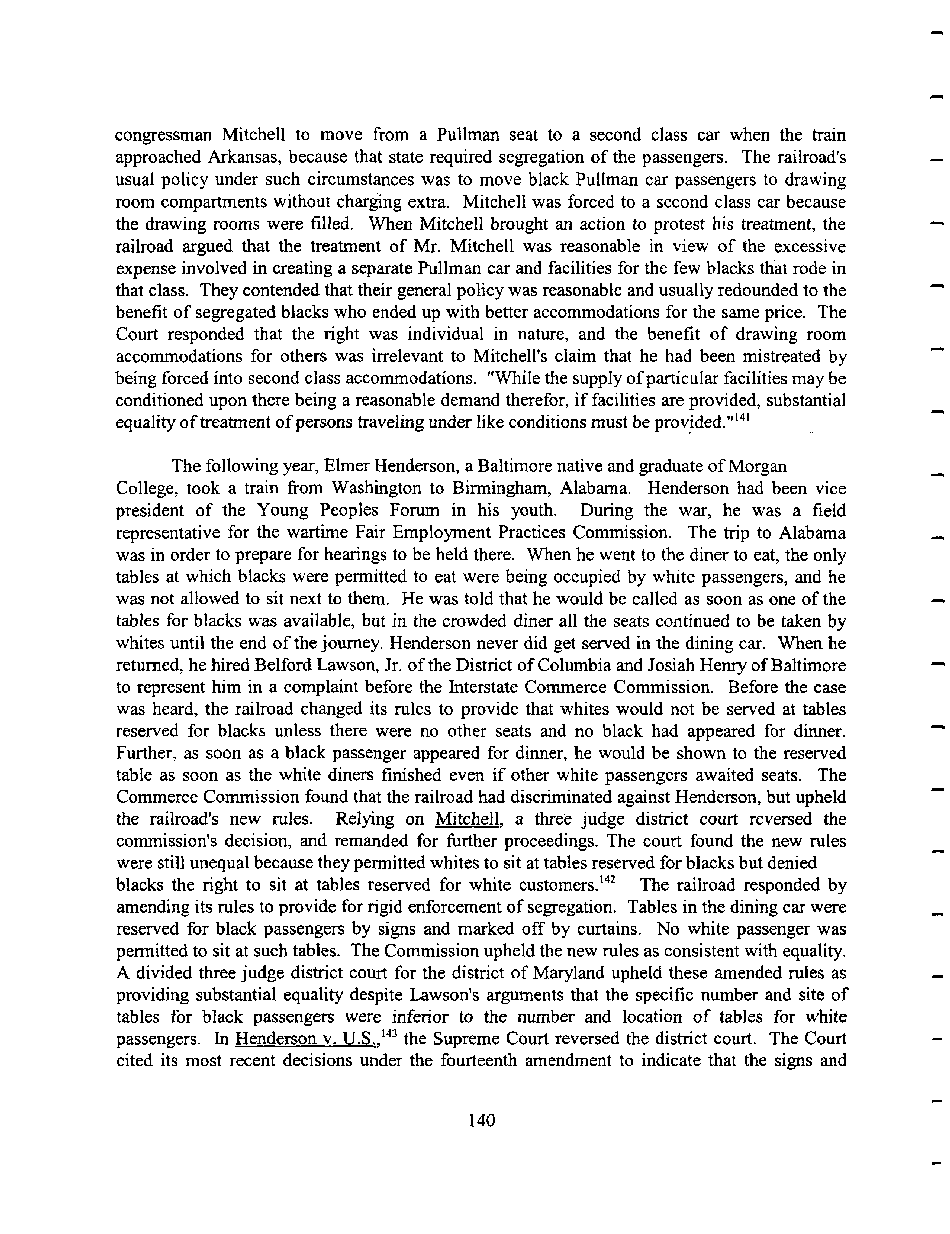|
congressman Mitchell to move from a Pullman seat to a second class car when the train
approached Arkansas, because that state required segregation of the passengers. The railroad's
usual policy under such circumstances was to move black Pullman car passengers to drawing
room compartments without charging extra. Mitchell was forced to a second class car because
the drawing rooms were filled. When Mitchell brought an action to protest his treatment, the
railroad argued that the treatment of Mr. Mitchell was reasonable in view of the excessive
expense involved in creating a separate Pullman car and facilities for the few blacks that rode in
that class. They contended that their general policy was reasonable and usually redounded to the
benefit of segregated blacks who ended up with better accommodations for the same price. The
Court responded that the right was individual in nature, and the benefit of drawing room
accommodations for others was irrelevant to Mitchell's claim that he had been mistreated by
being forced into second class accommodations. "While the supply of particular facilities may be
conditioned upon there being a reasonable demand therefor, if facilities are provided, substantial
equality of treatment of persons traveling under like conditions must be provided."141
The following year, Elmer Henderson, a Baltimore native and graduate of Morgan
College, took a train from Washington to Birmingham, Alabama. Henderson had been vice
president of the Young Peoples Forum in his youth. During the war, he was a field
representative for the wartime Fair Employment Practices Commission. The trip to Alabama
was in order to prepare for hearings to be held there. When he went to the diner to eat, the only
tables at which blacks were permitted to eat were being occupied by white passengers, and he
was not allowed to sit next to them. He was told that he would be called as soon as one of the
tables for blacks was available, but in the crowded diner all the seats continued to be taken by
whites until the end of the journey. Henderson never did get served in the dining car. When he
returned, he hired Belford Lawson, Jr. of the District of Columbia and Josiah Henry of Baltimore
to represent him in a complaint before the Interstate Commerce Commission. Before the case
was heard, the railroad changed its rules to provide that whites would not be served at tables
reserved for blacks unless there were no other seats and no black had appeared for dinner.
Further, as soon as a black passenger appeared for dinner, he would be shown to the reserved
table as soon as the white diners finished even if other white passengers awaited seats. The
Commerce Commission found that the railroad had discriminated against Henderson, but upheld
the railroad's new rules. Relying on Mitchell. a three judge district court reversed the
commission's decision, and remanded for further proceedings. The court found the new rules
were still unequal because they permitted whites to sit at tables reserved for blacks but denied
blacks the right to sit at tables reserved for white customers.142 The railroad responded by
amending its rules to provide for rigid enforcement of segregation. Tables in the dining car were
reserved for black passengers by signs and marked off by curtains. No white passenger was
permitted to sit at such tables. The Commission upheld the new rules as consistent with equality.
A divided three judge district court for the district of Maryland upheld these amended rules as
providing substantial equality despite Lawson's arguments that the specific number and site of
tables for black passengers were inferior to the number and location of tables for white
passengers, hi Henderson v. U.S..143 the Supreme Court reversed the district court. The Court
cited its most recent decisions under the fourteenth amendment to indicate that the signs and
140
�
|

